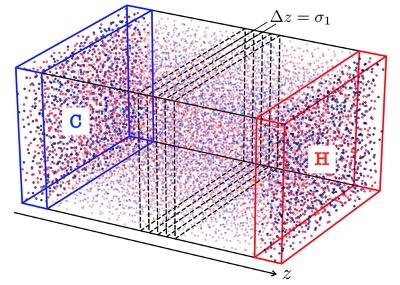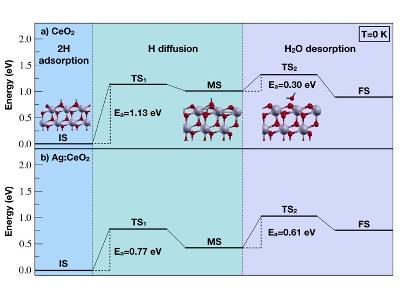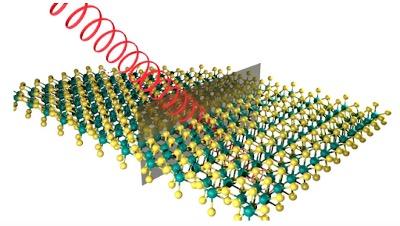The behaviour of electrons and ions in matter, from atoms to molecules and solids, is governed by the equations of quantum mechanics. Solving these equations allows to predict and design the properties of materials, and thus to inspire novel devices and technologies. Still, the solution of these equations provides a formidable task. At FIM we use and develop cutting-edge theoretical methods to tackle these problems, both with analytical tools and computational approaches that capitalize on the modern capabilities of high-performance and high-throughput computing, as well as data analytics. These methods are applied over a wide range of frontier technologies and exotic materials.
The activities at FIM are focused on:
- Methods for computation- and data-driven materials discovery
Classical and Quantum Multiscale Simulations
Theory of ground and excited states: Computational spectroscopy
High-performance and high-throughput computing - Materials for frontier technologies
Battery and energy materials
Chalcogenides for memory devices and neuromorphic applications
Nanostructures for optoelectronic applications
Solid-state devices for quantum technologies - Low-dimensional materials and emergent phenomena
Topological and excitonic insulators
Two-dimensional materials and van der Waals heterostructures
Nanotubes and nanoribbons
Surface and interface phenomena
Faculty
Rossella Brunetti, Mauro Ferrario, Anna Franchini, Carlo Jacoboni, Marco Gibertini, Rita Magri, Elisa Molinari, Alice Ruini, Raffaello Bianco, Marco Govoni

Simulations are becoming an essential tool to boost both scientific and technological progress in the search and discovery of innovative materials. They can be conducted at the atomistic scale within the laws of quantum mechanics, without need for any empirical input parameter, which confers them highly predictive power. For this reason, they are able to streamline, speed up, support and even – in some cases – replace experiments and spectroscopies that explore the interactions between matter and different probes, paving the way to relevant progress in research and innovation, also in industrial contexts. Further, the combination of such atomistic, first-principles methods with multiscale and classical simulation techniques allows to face problems and properties of increasing complexity, up to the simulation of whole nano-devices and bio-systems.
The UNIMORE group has a long-standing experience in such state-of-the-art computational schemes, also in association with automated high-throughput screening and data analytics approaches. Currently, we are strongly engaged in the development and innovation of cutting-edge theoretical methods, algorithms and codes, also in line with the present, huge progress in supercomputing and data technologies, which is providing a formidable thrust to this field.
Images adapted from Langmuir 33, 11281 (2017) and Nature Communications 8, 1461 (2017).
People: Prof. M. Ferrario, Dr. M. Gibertini, Prof. E. Molinari; Prof. A. Ruini, Dr. M. Govoni, Dr. R.Bianco; Dr. A. Ferretti (CNR), Dr. D. Prezzi (CNR), Dr. D. Varsano (CNR), Dr. S. Pittalis (CNR), Dr. C.A. Rozzi (CNR)

High-performance computations are used to investigate and design materials whose special properties make them suitable for innovative technologies and devices.The present theoretical and computational research employes approaches which range from continuous models to atomistic simulations to explore the properties of these materials, aiming at understanding the reasons behind their functioning in complex environments, thus optimizing their exploitation. Fruitful collaborations with international experimental groups allow to validate simulations against materials and device characterizations.
- Battery and energy materials
Polymer-functionalized nanostructures based on layered materials are proposed as new electrodes for the next-generation Li Ion batteries with self-healing properties (EU Project Bat4ever 2020-2023); surfaces and nanostructures of reducible metal oxides are proposed for applications in the new hydrogen-based technologies for clean energy production and climate change mitigation. - Chalcogenides for memory devices and neuromorphic applications
Microscopic electric transport models for amorphous chalcogenide phase-change materials and devices based on localised and extended states are carried out through the development of robust and efficient numerical procedures for the solution of sets of nonlinear differential equations of the hydrodynamic type. - Nanostructures for optoelectronic applications
Quantum dots and atomic defects in semiconductors are explored as possible sources of single-photon emitters for photonic and optoelectronic applications. Complex processes such as nanostructure growth and catalysis on surfaces are also simulated.
Images adapted from ACS Applied Materials & Interfaces 12, 27682 (2020) and J. Comput. El. 19, 128 (2019).
Main collaborations: CNR Institute for Microelectronics and Microsystems (Bologna, Catania); University of Bologna, Dipartimento dell’Energia elettrica e dell’Informazione Marconi; Intel Corporation, (CA, USA).
People: Prof. R. Brunetti, Prof. A. Franchini, Prof. C. Jacoboni, Prof. R. Magri, Dr. M.Govoni.

Low-dimensional materials are systems whose size in one or more spatial directions is sufficiently small to confine electronic states. The reduced dimensionality, with the corresponding change in phase space and the suppressed screening of electron-electron interactions, leads to a plethora of emergent phenomena and exceptional properties not displayed by their 3D counterparts. Similar effects can appear also at the surface of bulk materials or close to the interface between different compounds.
Modelling and simulating low-dimensional systems provide unprecedented and stimulating challenges. The purpose of this research group is to predict and design through advanced first-principles simulations a wide range of phenomena arising in novel low-dimensional materials, from 1D carbon nanotubes and graphene nanoribbons, to 2D exfoliable materials and their heterostructures. Particular emphasis is given to excitonic and topological insulators, magnetism, many-body phenomena, optical excitations, phonons and their interactions with electrons.
Images adapted from Nature Nanotechnology 15, 367 (2020) and . Phys. Rev. Lett. 120, 117701 (2018).
People: Prof. E. Molinari; Prof. A. Ruini, Dr. M. Gibertini, Dr. R.Bianco, Dr. M. Govoni; Dr. D. Varsano (CNR), Dr. A. Ferretti (CNR), Dr. P. D’Amico (CNR), Dr. D. Prezzi (CNR), Dr. M. Rontani (CNR).